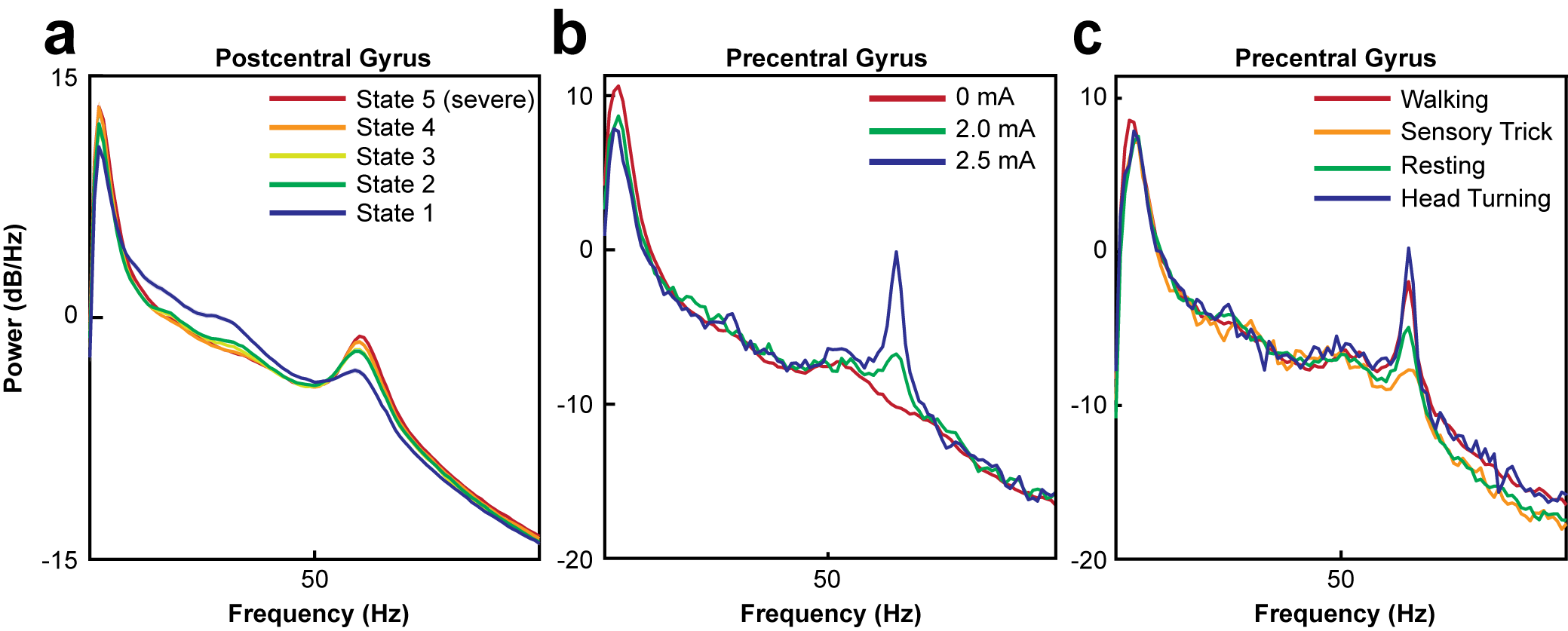Category: Dystonia: Pathophysiology, Imaging
Objective: To characterize the functional role of finely tuned gamma (FTG) oscillations across the motor network in freely-moving patients with dystonia.
Background: FTG has been implicated as a potential “prokinetic” frequency in both Parkinson’s disease (PD) [1] and dystonia [2], and entrainment of FTG by deep brain stimulation (DBS) has been observed and is hypothesized to be a mechanism of DBS. Previously, we have demonstrated intraoperatively in a patient with isolated dystonia that cortical FTG was induced during dystonic posturing [2]. However, both native (off-stimulation) and DBS-entrained FTG have not been extensively studied, and never studied in long-term sensorimotor recordings.
Method: Local field potential recordings from both basal ganglia and cortical leads (covering precentral and postcentral gyri) were performed in two patients with isolated dystonia during normal daily activities, using a sensing-enabled DBS device (Summit® RC+S, Medtronic) designed for chronic wireless streaming of neural time series data. Recordings were paired with a head-worn accelerometer. Activities of daily living were reported through a patient-facing graphical user interface [3]. Time series data were divided into 20-second epochs and the power spectral density was estimated using Welch’s method. The degree of head acceleration was defined using percentiles derived from the acceleration envelope across an individual’s at-home recordings. The 20th, 40th, 60th, and 80th percentiles were calculated and served as thresholds for different severity states (Fig. a).
Results: Over 420 hours of time series data were recorded. Both native and entrained FTG were observed across patients. Native FTG was of highest amplitude on postcentral gyrus and increased with more severe head movements (Fig. a). Entrained FTG (at half stimulation frequency) was more prominent on precentral gyrus, increased with stimulation amplitude (Fig. b) and modulated in amplitude across activities of daily living (Fig. c).
Conclusion: Chronic sensorimotor recordings in patients with isolated dystonia reveal that oscillatory activity that is pro-kinetic and pro-dyskinetic in PD, may also modulate with severity in isolated dystonia. Therapeutic DBS alters the topography of cortical gamma oscillations. These signals may potentially be used to optimize programming or in adaptive DBS protocols in patients with dystonia.
References: [1] N. C. Swann et al., “Gamma Oscillations in the Hyperkinetic State Detected with Chronic Human Brain Recordings in Parkinson’s Disease,” J. Neurosci., 2016. [2] S. Miocinovic et al., “Cortical gamma oscillations in isolated dystonia,” Parkinsonism Relat. Disord., 2018 [3] R. Gilron et al., “Long-term wireless streaming of neural recordings for circuit discovery and adaptive stimulation in individuals with Parkinson’s disease,” Nat. Biotechnol., 2021.
To cite this abstract in AMA style:
S. Cernera, M. Olaru, C. Oehrn, S. Little, P. Starr. Finely tuned gamma oscillations across the motor system in patients with isolated dystonia implanted with sensing-enabled pulse generators [abstract]. Mov Disord. 2022; 37 (suppl 2). https://www.mdsabstracts.org/abstract/finely-tuned-gamma-oscillations-across-the-motor-system-in-patients-with-isolated-dystonia-implanted-with-sensing-enabled-pulse-generators/. Accessed March 31, 2025.« Back to 2022 International Congress
MDS Abstracts - https://www.mdsabstracts.org/abstract/finely-tuned-gamma-oscillations-across-the-motor-system-in-patients-with-isolated-dystonia-implanted-with-sensing-enabled-pulse-generators/

